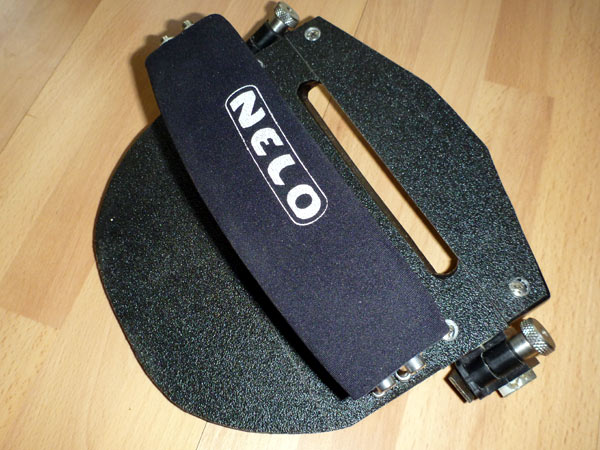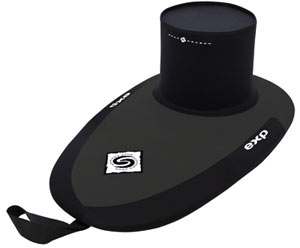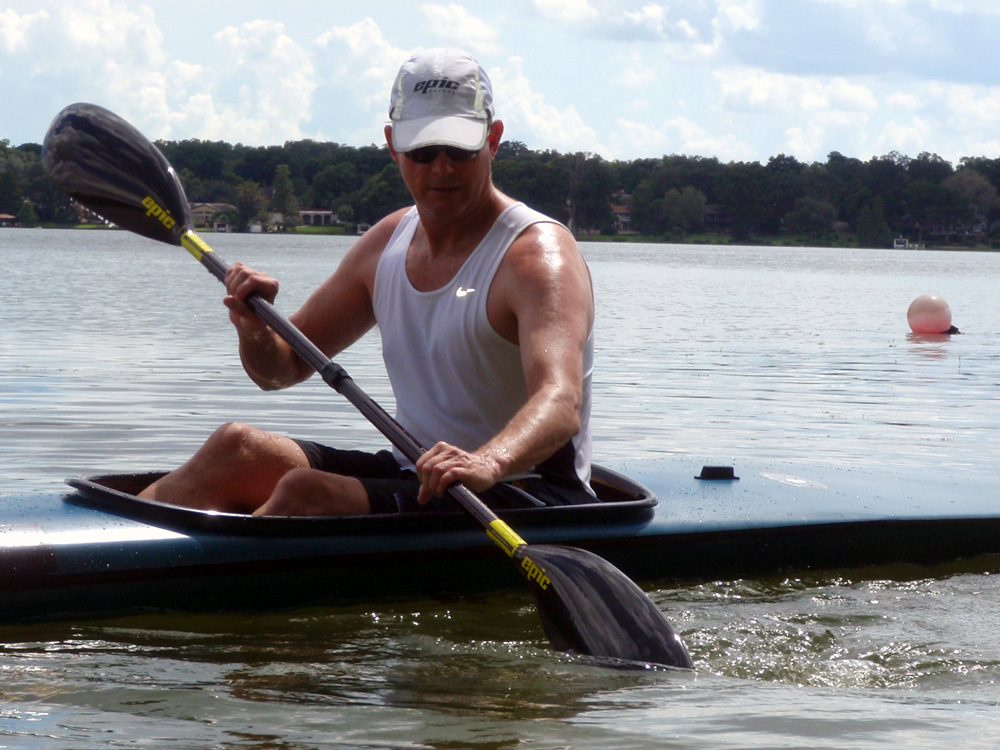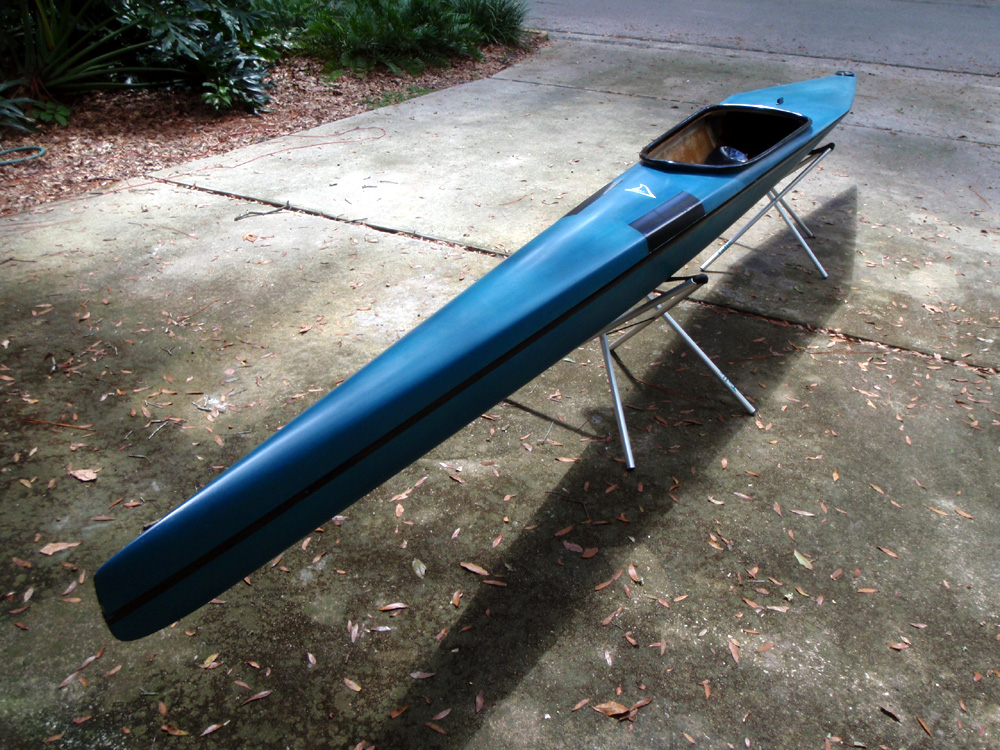Posted by Greg on
February 12, 2012
Q: You have stated that the Greenland Paddle (GP) can act as a wing when the GP is used in a high wing type stroke. Have you done a test in your fast kayak, GP vs wing to determine advantages of one or the other with respect to efficiency and/or speed in non racing situations, eg., outings from 5 to 15 miles?
I have acquired both a wing (Onno) and a GP (Novorca) in the last year and have been learning both. At 4.2 kts, my traveling speed, the GP feels more efficient, but I can go at least 0.2 kts faster with the wing. Jerry
A: Jerry, Although I realize that you said non-racing situations, let me use that as an example, first, as it helps to clarify the issue.
To generalize, a racer is often trying to maximize speed over distance usually with an extremely light, unladen kayak. A sea kayaker is often trying the maximize the number of “miles per Snickers bars”, often with a heavy or gear-laden kayak, day after day. These are related, but are very different things and need to be viewed separately. Read more... (1200 words, 4 images, estimated 4:48 mins reading time)
Posted by Greg on
February 3, 2012
Q: What would you suggest to someone who wants to unlearn unwinding before the catch and start to get good muscle memory for catch before unwinding.
Because the kayak is already moving I find myself unwinding – irresistibly! ;-( before catch. Apart from visualizing spearing a salmon, do you have other advice, tips, tricks, dry/ wet exercises etc to catch before unwinding?
A: When I do video analysis of students a common error is unwinding before the catch, or in other words, starting to apply power before the paddle is completely buried. This is a common power leak.
If you are “pulling” before the paddle is planted, not only is your stroke shortened (giving you less time to generate power), but the catch is often poor too (drawing air into the water — ventilation, and creating turbulence and making noise — “plop!”).
How short is a “model” stroke? For a wing you should be starting your exit when the blade reaches your knees and the blade should exit when your hand reaches your hip. Since the stroke is so short, you can’t afford to waste any of it. A Greenland paddle also exits when your hand is at your hip, but the blades are long, and will exit behind you. Read more... (655 words, 0 images, estimated 2:37 mins reading time)
Posted by Greg on
February 1, 2012


My latest DIY project was to create a full footboard to replace the skimpy original on my K1 (right).
This was a relatively quick and inexpensive project. First task was to make a cardboard pattern to determine the size and fit. For the construction I used 1/2″ (12.7mm) thick birch plywood, but it’s stronger than it needs to be, 3/8″ (9.5mm) thickness would be fine, and would save a little weight.
The only challenging part of the operation was to cut the slot for the tiller bar (rudder control) as this needs to be cut at the same angle as the slope of the footboard or the tiller will stick. My approach was to drill two holes at each end of the slot using an old-fashioned bit-brace (hand drill) with a bit the same diameter as the intended slot. To get the angle right, I placed a sliding T bevel set at 60 degrees on the stock and just eyeballed it as I drilled. A sabre saw with an adjustable base (set to 60 degrees) made quick work of cutting the waste from the slot. Read more... (968 words, 3 images, estimated 3:52 mins reading time)
Posted by Greg on
January 27, 2012
Q: I would like to get the most out of my forward stroke with a Greenland Paddle, but I have been told different things about how to use the GP. Most emphasize torso rotation. Some say it is better not worry too much about rotation, but instead to reach and lean slightly forward, insert the paddle, then pull and sit-up. Some say to take the paddle out at the waist, as with an Euro-paddle. Some say to pull the paddle all the way through the stroke. Is there a style best suited to the GP and a Greenland style boat that gives the most power for the effort?
— Tom in North Carolina
A: Tom, thanks for the question.
Before going into specific techniques, following are some general points to ponder. There is a lot of condensed information here, you may have to read this more than once. Read more... (2095 words, 1 image, estimated 8:23 mins reading time)
- Move the boat through the water, not the paddle. This is a huge mental change for most paddlers. Think of your paddle as an anchor that you plant into solid ground and then lever your boat forward using strong legwork and body rotation. When done properly you should be able to feel your paddle “load-up” with tension — it feels somewhat like you are suspended from the paddle, like hanging from a bar.
Posted by Greg on
January 24, 2012
Q: I want a Snapdragon skirt that will be good for Fla paddling and rolling. I want something to seal well. Which Snapdragon do you recommend? I paddle a Force 5 and a rm Chatham 17….Thanks. Dave
A: Dave, For full disclosure, I’m a Snapdragon team paddler but I bought Snapdragon before I was sponsored, they make a great product.
I have multiple skirts that I choose depending on my activity/conditions. The most bombproof skirts are full neoprene, they are dry but also warm (not an advantage in the Florida heat).
If your priority is a solid seal (good for surf, rolling practice, rough water play, etc), then I recommend the Ocean Tour EXP Reinforced skirt; this neoprene skirt is dry and tough  enough for heavy surf zones. If I had to pick only one skirt, it would be this one. I used this skirt for paddling around Iceland where it withstood the nasty dumping waves of the South Coast without imploding. It works equally as well with the dumpers we have at Canaveral on the East coast. If you don’t need the heavy-duty rim guard and other extreme durability features then the Ocean Trek is a good choice, it’s just as dry. Read more... (414 words, 2 images, estimated 1:39 mins reading time)
enough for heavy surf zones. If I had to pick only one skirt, it would be this one. I used this skirt for paddling around Iceland where it withstood the nasty dumping waves of the South Coast without imploding. It works equally as well with the dumpers we have at Canaveral on the East coast. If you don’t need the heavy-duty rim guard and other extreme durability features then the Ocean Trek is a good choice, it’s just as dry. Read more... (414 words, 2 images, estimated 1:39 mins reading time)
Posted by Greg on
January 21, 2012
In case that “Google” or “Ask Jeeves” isn’t sufficient to answer your kayak question, next time try “Ask Greg”! 😉
You can find my new Ask Greg page among the options at the top of the screen. Please keep it in mind the next time you have a question or want to browse.
I look forward to helping you with any kayaking questions you might have.
Posted by Greg on
January 20, 2012
Q: I have read different things about how to find the best length for a Greenland paddle and some of the methods result in very different sizes. Is there a traditional method to find the exact paddle size. Thanks! — Confused in Portland
A: Hello “Confused”. Greenland paddle sizing is usually done using anthropometric measurements. This type of measurement takes into account body sizing, and can be done directly, without a tape measure.
For the measurements below, an “armspan” refers to the full reach of your outstretched arms, from the extended fingertips of one hand, to the other. Read more... (455 words, 0 images, estimated 1:49 mins reading time)
- The most commonly-used method for touring is one armspan , plus a cubit (the distance from your elbow to your extended fingertips).
- For competition rolling, and kayaking in very windy areas, you may want a slightly shorter paddle — a common length is an armspan plus the distance from your wrist to your fingertips. A shorter paddle is easier to maneuver both underwater and in a strong wind.
- For a very short paddle used with a sliding stroke (often called a “storm paddle”), the length is short – one armspan, with the loom only two or three fists wide.
Posted by Greg on
January 11, 2012

I’m happy to report that my fragile male ego wasn’t bruised too badly, first time in a K1 🙂 At least I didn’t unintentionally swim but my bracing and sculling skills were heavily tested. My girlfriend, Pauline Besson, did very well, and managed to stay upright, but did have a capsize or two. Most other friends who tried it went about fifteen feet, the boat flopped to its side, and into the drink they went.
“You’ve got to be kidding me!”
For the first few minutes Pauline stabilized the K1 while I simply got accustomed to the feel. My first thought was, “You’ve got to be kidding me”! I was (over) confident that it would be a piece of cake, however the initial stability, or rather the lack of it, was much different to anything I have been in before, and that includes some very narrow V-hulled boats.
I knew the key was to relax, but my hip-flexors went into overdrive trying to balance. Nervous waves radiated quickly away from the kayak. “Stop IT!”, I barked to myself and the quivering boat. After a few minutes I finally relaxed and could balance by using the buoyancy of the paddle and by gently sculling. I used a Greenland paddle for this due to its familiarity, buoyancy and ease of sculling and bracing. Read more... (1195 words, 4 images, estimated 4:47 mins reading time)
Posted by Greg on
January 6, 2012

… Only tippy paddlers.
At least that’s what I used to tell students …. before I tried a K1 sprint kayak.
So why a K1? I’m working with computers again — great for cash flow and rebuilding bank accounts, but not so great for long trips and expeditions. However the silver lining is that there is plenty of time to train and complete in the local races, grow stronger, and learn some new skills. Also, my interest was piqued by what I have heard about these slender hulls. Surf the web and you will discover comments such as “the K1 is the formula 1 of the kayaking world”, “separates the men from the boys” , and “if you can paddle a K1 you can paddle anything!”. While it’s best to treat what you read on the internet with healthy skepticism, that sounds like a challenge if I ever heard one!
I always find it rewarding to branch out into other aspects of the diverse world of kayak-sport. Being a “beginner” again in a new discipline is humbling, keeps you grounded and you experience the thrill of rapidly learning and improving. That’s great fun if you have been doing something for years or if you feel your skills have plateaued. Read more... (710 words, 3 images, estimated 2:50 mins reading time)
Posted by Greg on
January 4, 2012
One of my nagging New Year’s resolutions was to post more often. I’m usually on to the next project/trip without wanting to write about the previous one…
I’m in the process of updating this blog to a new version of WordPress.
During this time the site may be down or incomplete. Please check back soon.
Best,
Greg Stamer





